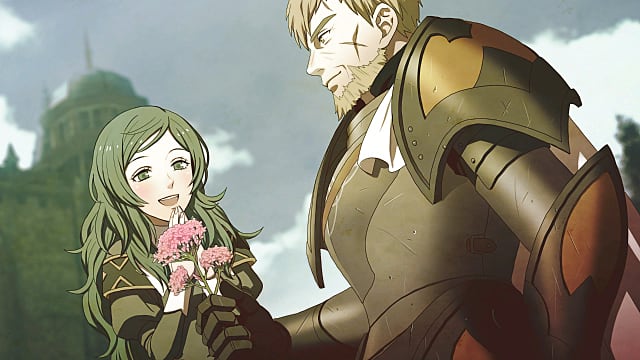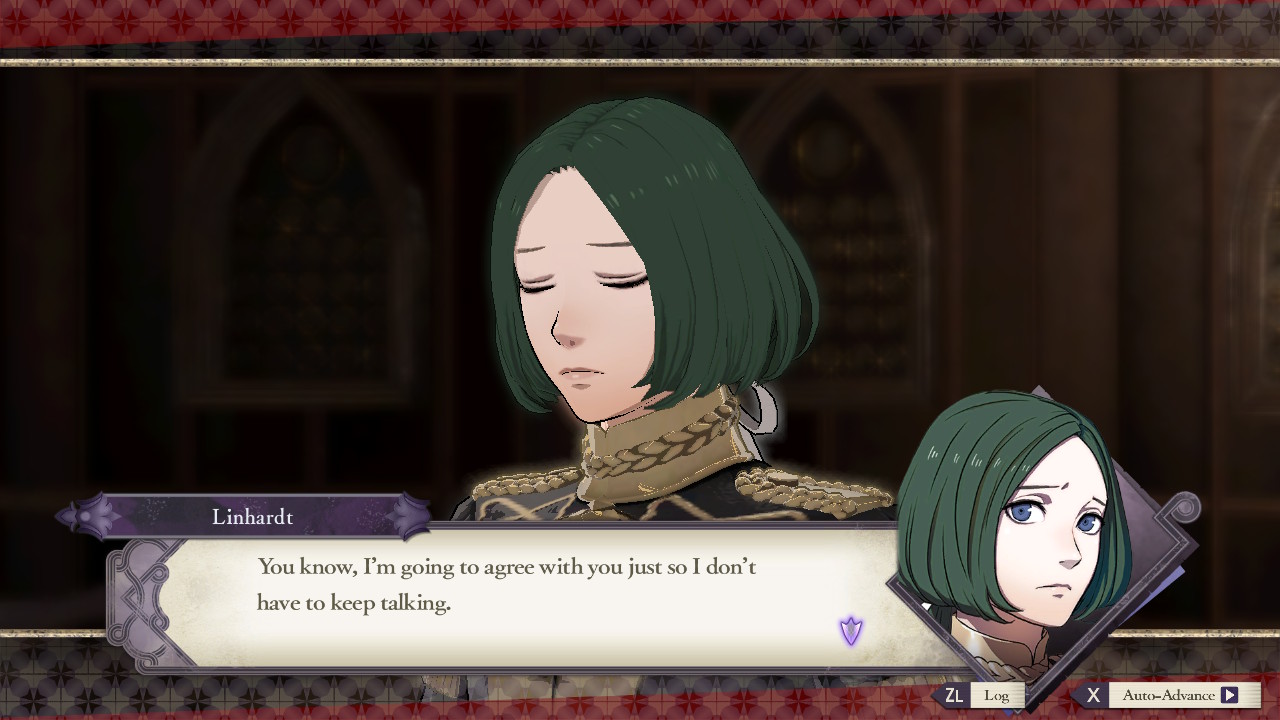Fire Emblem: Three Houses’ expansion pass is finally complete with the release of the side-story content, Cindered Shadows.
The DLC is definitely the meatiest portion of the expansion pass and promises a completely different take on monastery life and the game’s overall combat. But does it live up to its namesake?
Fire Emblem: Three Houses Cindered Shadows Review — Smouldered Glory
Cindered Shadows is a separate story right from the start. You’ll pick your protagonist, gender, and name all over again, and support and ability levels are fixed throughout. It all begins sometime after Chapter 2 of the main game, once the Rite of Rebirth gets crashed.
Byleth (or whatever you call them) and the House leaders notice someone suspicious lurking around Garreg Mach and go to investigate after being joined by one student from each house: Linhardt from the Black Eagles, Hilda from the Golden Deer, and Ashe from the Blue Lions. This is your posse for the next eight hours or so.
It’s not much of an army, but your group gets some big new additions after finishing the first battle. After that, you’ll make nice with the Ashen Wolves house in Abyss, consisting of just four students: Yuri, Constance, Balthus, and Hapi.
You might be a hotshot yourself and have three world-changers along with you, but these four are the heart of the Cindered Shadows story — except they also aren’t to an extent, but more on that later.
Like in Three Houses’ main campaign, Cindered Shadows’ main plot beats aren’t too hard to guess, and you’ll immediately figure out who these four subterranean dwellers are. The question then becomes why they’re here.
Despite being a side story, the narrative has a great deal of relevance to the main plot. I won’t spoil any of it further than saying Byleth and Rhea both get some very good, and very necessary, character development.
Also like Three Houses, the main fun comes from watching these events unfold and seeing how they fit with what you already know about the world from the main story and, more importantly, how the characters respond to them.
The four Ashen Wolves are, undoubtedly, some of the best characters in Three Houses, both in their combat usefulness and how they’re written. It’s true their stories are central to the experience, but for me, the unspoken star here is Abyss itself.
This is where all the rejects in society end up — sick people, poor people, rogues, undesirables of all sorts. It’s also where those who simply got left behind call home. There are nobles here, but even they have no influence anymore, fallen from grace as they are.
The Church of Seiros tolerates Abyss because it thinks the people are necessary to keep the world balanced, but “tolerance” just means “lets them live without the light of day and might wipe them out eventually. It depends on the day.”
Though the story is brief, it’s a hugely refreshing spin on a world many of us have already spent hundreds of hours in. I mentioned in our original Three Houses review this is one of the most richly-realized Fire Emblem worlds. If anything, it’s just a bit disappointing the entire story was finished in Three Houses, because Cindered Shadows proves there’s a host of possibilities in exploring the various characters and perspectives the world has to offer.
Of course, Fire Emblem is a strategy game before it’s an RPG, and bad maps can bring the best stories down.
Here, we get four new maps, one of which is the monastery’s Cathedral (!!). Cindered Shadows doesn’t exactly break the mold of map creativity, even re-using one of the new maps, but it does use its assets in some excellent ways.
Sometimes, you’ll have to suss out the best route in a large, open map; others, you’ll be stretched to your limit, beset on all sides by countless foes. I played on Hard, and it’s a lot like Maddening mode. Enemies are at least five or more levels stronger than you, Gambits are an absolute necessity — but need to be used wisely — and you’ll live or die by your clever use of Combat Arts.
The penultimate map and the final boss are actually some of the best Fire Emblem we’ve seen in years in terms of making you use each system to its fullest.
Fortunately, the same options for Normal or Hard, Casual or Classic, exist here, so someone wanting less of an ordeal can still find plenty of fun. Plus there’s an excellent new BGM track.
And then it ends.
It’s a satisfying ending, no doubt about it, but the integration with the main story leaves something to be desired. That’s because the Cindered Shadows scenario has a distinct ending with no relation to the main story, and then you re-load your main story file and recruit all four Ashen Wolves who don’t even know you now.
I can’t imagine the effort required to somehow link the two scenarios more smoothly, but it’s still a bit jarring.
Luckily, that sense of discombobulation doesn’t last. Completing the side story is just one part of the expansion, and the Abyss you unlock after completion has a lot going for it, even with the odd transition.
The biggest thing is, of course, introducing four new classes: War Monk/Cleric, Dark Flier, Trickster, and Valkyrie. Just this small addition can completely change how you develop your students, and best of all, it fixes two big issues from the main campaign.
Brawling classes were once exclusive to men, which was a bit odd because Hilda and others were perfect for brawling. War Cleric fixes that. Mages in the main game are sadly limited in their class choices after Intermediate level.
Then you had the oddity of characters excelling in skills that would never do them any good; for example, it was pointless leveling up skills like Flayn’s lance skill because flying classes can’t use magic. Enter the Dark Flier, which requires those skills, and Valkyrie, which gives you even more options for your magic wielders.
To get these, you’ll need to develop the Abyss by spending your Renown and taking on some fundamental quests; this unlocks the option to trade Renown for items — like the Abyssian Exam Seal — at the Pagan Altar in Abyss. If you’re starved for Renown for whatever reason, don’t worry. You get 10,000 Renown just for finishing Cindered Shadows.
You can level up Abyss itself by spending Renown, bringing in new helpful characters like the stat evaluator, and generally making it more livable for the folks there on the whole.
The four Ashen Wolves get some very good support conversations as well, mostly with each other, but also with Byleth (in fact, Yuri can marry both Byleths) and a select few other students. You’ll want them on your team for sure.
Fire Emblem: Three Houses Cindered Shadows — The Verdict 
Pros
- Great story and overall worldbuilding
- Fantastic combat scenarios
- Carries over into the main game for even more reason to keep playing
Cons
- Jarring transition into the main game
- New classes aren’t available except through the expansion pass.
Barring some iffy integration and the fact that new classes are locked behind DLC, Cindered Shadows and the Three House expansion pass are completely worth it. Though short, the story is a chance to learn more about some vital players in the main game and get a new look at the world itself.
The combat is the best Fire Emblem combat in years, and you get some very good carryovers into the main game that make it worth going back yet again to re-shape the world.
[Note: A copy of Fire Emblem: Three Houses Cindered Shadows was provided for the purpose of this review.]










Published: Feb 17, 2020 03:05 pm